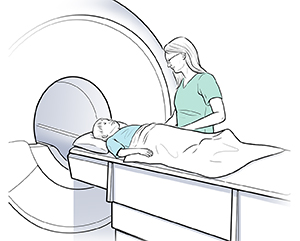When Your Child Has Neurofibromatosis Type 2 (NF2)
Neurofibromatosis type 2 (NF2) is a condition that makes certain nerve cells more likely to develop tumors. With NF2, tumors are most often found along the nerves to the ears (auditory nerves). This can lead to hearing loss and problems with balance. Often these tumors happen in both ears. Tumors can also develop along nerves coming out of the brain and spinal cord. Your child’s healthcare provider will tell you more about your child’s condition and treatment choices for your child.
What causes NF2?
NF2 is caused by a change (mutation) in specific genes that affect nerve growth. This mutation often happens by chance. It can also be passed down in families (inherited). If a diagnosis is confirmed, parents and siblings should be evaluated for the condition as well.
What are the symptoms of NF2?
Symptoms vary for each child. They can also be hard to recognize during childhood. So the diagnosis is often not made until the child is in their 20s or 30s. The symptoms may also be affected by the location of the tumors. Your child may have:
How is NF2 diagnosed?
Your child will likely see a pediatric neurologist for diagnosis and treatment. This is a healthcare provider who specializes in neurologic problems in children. If NF2 is suspected, the following may be done:
-
Nervous system exam. This is done to check how well your child’s nervous system is working. During the exam, the healthcare provider checks your child’s muscle strength, balance, coordination, and reflexes. They also check skills such as hearing or vision.
-
Eye exam. This is done to evaluate for vision changes, cataracts, and ocular pressure.
-
Hearing exam. This is done to evaluate your child's hearing.
-
Health history. This helps to learn more about your child’s symptoms, other health problems, and family health history.
-
Imaging tests. These may include an MRI or CT scan to check tumor size and location.
-
Genetic tests. These special blood tests check for the gene mutation.
 |
| With NF2, your child may have an imaging test, such as an MRI or CT scan, to check for tumors. |
Diagnosis of NF2 requires one of the following:
-
Bilateral vestibular schwannoma, also known as an acoustic neuroma. This slow-growing tumor can lead to hearing loss, ringing in the ears, or weak facial muscles.
-
Parent or sibling with NF2
Or any two of the following:
How is NF2 treated?
Surgery to remove any tumors is the most common treatment. Surgery has many risks and benefits. The healthcare provider will talk about these with you in detail. In rare cases, a tumor can become cancer (malignant). This may require other treatments such as radiation or chemotherapy. In some cases, a device called a cochlear implant can help restore hearing. This requires surgery. Your child's healthcare provider will go over this option if your child's hearing becomes affected.
What are the long-term concerns?
The outcome for your child varies depending on the severity of his or her condition. After treatment, many children can be as active and independent as other children. Other tumors affecting the nervous system can occur, but they are rare. So your child may need close monitoring. If a tumor was removed along the auditory nerve, your child may have lasting (permanent) hearing loss after treatment. Ask your child’s healthcare provider about supportive care that can help your child learn to manage their disability.
To learn more
NF2 is linked to a risk for tumors. These include schwannomas, meningiomas, and low-grade ependymomas. Children with NF2 must be evaluated regularly to diagnose these tumors at an early stage.
A positive outlook helps while supporting your child. Encourage your child to be active and to try new things. Think about getting counseling. This can help you and your child deal with any fears or concerns. And seek help from friends, community resources, and support groups. The more you learn about your child’s condition and its treatments, the more in control you may feel. For more information about neurofibromatosis, contact the following organizations: